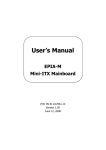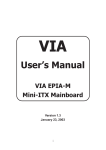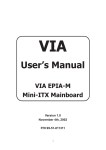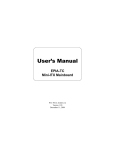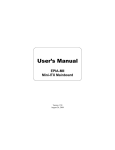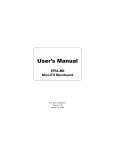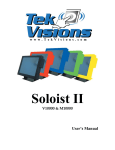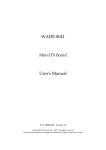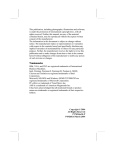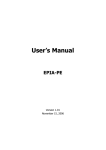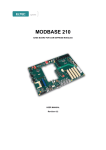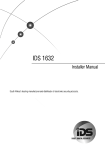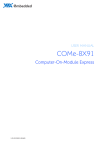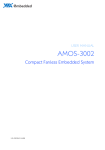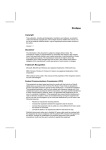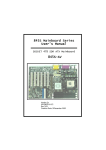Download User`s Manual - Mini
Transcript
User’s Manual P4-ITX Mini-ITX Mainboard PN 99-51-012801-12 Version 1.2 August 21, 2003 Copyright Copyright by Insight Solutions Inc.. No part of this manual may be reproduced or transmitted in any form without express written authorization from Insight Solutions. Trademarks All trademarks are the property of their respective holders. PS/2 and OS/2 are registered trademarks of IBM Corporation. Windows 95/98/98SE/ME/2000/NT and Windows XP are registered trademarks of Microsoft. Award is a registered trademark of Award Software Inc. Data protection All data should be backed-up prior to the installation of any drive unit or storage peripheral. Insight Solutions will not be responsible for any loss of data resulting from the use, disuse or misuse of this or any other Insight Solutions product. No Warranty Insight Solutions has made every effort to ensure the accuracy of the content of this manual. However, it is possible that it may contain technical inaccuracies or typographical or other errors. Our products are under continual improvement and we reserve the right to make changes without notice. Insight Solutions will assume no liability for any inaccuracy found in this publication, nor for damages, direct, indirect, incidental, consequential or otherwise, that may result from such an inaccuracy, including without limitation loss of data or profits. Insight Solutions provides this manual “as is”, and does not issue a warranty of any kind, express or implied, including without limitation implied warranties of merchantability or fitness for a particular purpose. The information provided in this manual is subject to change without notice. Insight Solutions reserves the right to alter product designs, layouts or drivers without notification. ii FCC-B Radio Frequency Interference Statement This equipment has been tested and found to comply with the limits for a class B digital device, pursuant to part 15 of the FCC rules. These limits are designed to provide reasonable protection against harmful interference when the equipment is operated in a commercial environment. This equipment generates, uses and can radiate radio frequency energy and, if not installed and used in accordance with the instruction manual, may cause harmful interference to radio communications. Operation of this equipment in a residential area is likely to cause harmful interference, in which case the user will be required to correct the interference at his own expense. Notice 1 The changes or modifications not expressly approved by the party responsible for compliance could void the user’s authority to operate the equipment. Notice 2 Shielded interface cables and A.C. power cord, if any, must be used in order to comply with the emission limits. iii Safety Instructions 1. Always read the safety instructions carefully. 2. Keep this User’s Manual for future reference. 3. Keep this equipment away from humidity. 4. Lay this equipment on a reliable flat surface before setting it up. 5. The openings on the enclosure are for air convection hence protects the equipment from overheating. DO NOT COVER THE OPENINGS. 6. Make sure the voltage of the power source and adjust properly 110/220V before connecting the equipment to the power inlet. 7. Place the power cord in such a way that people cannot step on it. Do not place anything over the power cord. 8. Always unplug the power cord before inserting any add-on card or module. 9. All cautions and warnings on the equipment should be noted. 10. Never pour any liquid into the opening. Liquid can cause damage or electrical shock. 11. If any of the following situations arises, get the equipment checked by a service personnel: • The power cord or plug is damaged • Liquid has penetrated into the equipment • The equipment has been exposed to moisture • The equipment has not work well or you can not get it work according to User’s Manual. • The equipment has dropped and damaged • If the equipment has obvious sign of breakage 12. DO NOT LEAVE THIS EQUIPMENT IN AN ENVIRONMENT UNCONDITIONED, STORAGE TEMPERATURE ABOVE 60 C (140 F), IT MAY DAMAGE THE EQUIPMENT. 0 0 CAUTION: Explosion or serious damage may occur if the battery is incorrectly replaced. Replace only with the same or equivalent type recommended by the manufacturer. iv Box Contents • 1 x Insight Solutions Mainboard • 1 x User’s Manual • 1 x Floppy Ribbon Cable • 1 x ATA-33/66/100/133 IDE Ribbon Cable • 1 x IO Bracket • 1 x Driver Utilities CD v Table of Contents Chapter 1: Specifications ........................................1-1 Mainboard Specifications ..........................................................1-2 Mainboard Layout .....................................................................1-4 Back Panel Ports ......................................................................1-5 Slots ..........................................................................................1-5 Onboard Connectors and Jumpers ...........................................1-6 Chapter 2: Installation..............................................2-1 CPU Installation ........................................................................2-2 Memory Module Installation ......................................................2-5 Connecting the Power Supply...................................................2-7 Back Panel Ports ......................................................................2-8 Connectors..............................................................................2-12 Jumpers ..................................................................................2-20 Slots ........................................................................................2-22 Chapter 3: BIOS Setup .............................................3-1 Entering Setup ..........................................................................3-2 Control Keys .............................................................................3-2 Getting Help ..............................................................................3-3 The Main Menu .........................................................................3-4 Standard CMOS Features ........................................................3-6 Advanced BIOS Features .........................................................3-8 Advanced Chipset Features....................................................3-12 Integrated Peripherals.............................................................3-15 Power Management Setup .....................................................3-19 PnP / PCI Configurations ........................................................3-24 PC Health Status ....................................................................3-26 Frequency Control ..................................................................3-27 Load Fail-Safe Defaults ..........................................................3-29 Load Optimized Defaults.........................................................3-30 Set Supervisor / User Password .............................................3-31 Save & Exit Setup ...................................................................3-33 Exit Without Saving .................................................................3-34 Chapter 4: Driver Installation ..................................4-1 Driver Utilities CD Content ........................................................4-2 vi Appendix A: Smart 5.1 ............................................ A-1 Intelligent 6-Channel Audio ...................................................... A-2 Hyper-Threading Technology .................................................. A-9 vii Chapter 1 Specifications The ultra-compact and highly intergrated Insight Solutions P4-ITX Mini-ITX Mainboard is the smallest form factor mainboard specification available today, developed by VIA Technologies, Inc. as part of the company’s open industry-wide total connectivity initiative. The mainboard enables the creation of an exciting new generation of small, ergonomic, innovative and affordable embedded systems. Through high level of integration, miniITX only occupy 66% of the size of FlexATX mainboard form factor. This chapter includes the following sections: Mainboard Specifications 1-2 Mainboard Layout 1-4 Back Panel Ports 1-5 Slots 1-5 Connectors / Jumpers 1-6 1-1 Chapter 1 Mainboard Specifications CPU • Intel® Pentium® 4, Celeron® Processor (Willamette / Northwood 478pin) • 533 / 400 MHz Front Side Bus Support up to 3.06 GHz CPU only Chipset • VIA P4N266A North Bridge • VT8235 South Bridge Memory • 1 x DDR266 DIMM socket (up to 1 GB) Expansion Slots • 1 x PCI Graphics • Integrated S3 ProSavage8 AGP4X graphics Audio • VIA VT1616, six-channel AC’97 Codec IEEE 1394 • VIA VT6307S, IEEE 1394 LAN • VIA VT6103 10 / 100 Base-T Ethernet PHY IDE • 2 x UltraDMA 133/100/66 Connector Floppy • 1 x FDD Connector 1-2 Specifications Back Panel I/O Ports • 1 x PS2 mouse port • 1 x PS2 keyboard port • 1 x VGA port • 1 x S-Video port • 1 x RCA port (used for either SPDIF or TV-out) • 1 x Parallel • 1 x RJ-45 LAN port • 2 x USB 2.0/1.1 ports • 1 x Serial port • 3 x Audio jacks: line-out, line-in and mic-in Onboard I/O Connectors • 2 x USB conncetors for 4 additional USB 2.0 ports • 1 x IEEE 1394 Port • 1 x Front-panel Audio pin-header for Line-Out, MIC-In • 1 x CD Audio-in connector • 1 x Buzzer • 1 x SM Bus connector • 1 x SIR connector • 1 x CIR connector (Switchable for KB / MS) • 1 x Wake-on-LAN connector • 3 x Fan connectors (CPU Fan / SYS Fan / Fan 3) • 1 x Connectors for LVDS module (Optional) • 1 x Serial port connector for second COM port BIOS • Award BIOS on 2/4Mbit flash memory Form Factor • 17 cm X 17 cm Mini-ITX (4 layers) 1-3 Chapter 1 Mainboard Layout CIR DIMM Top: Mouse Bottom: Keyboard ATXPWR AUX12V CPUFAN VGA Out CPU Socket FDD Top: RJ45 Bottom: USB IDE1 IDE2 Top: Parallel Bottom (L): S-Video Bottom (M): RCA/SPDIF Bottom (R): COM1 GAME_PORT SPDIF_SEL WOL COM2 CD_IN USB 3/4 USB 5/6 N A SYSFAN LVDS CMOS BATTERY FAN3 Audio Jacks F_PANEL CLEAR_CMOS 1394 F_AUDIO 1394/EN1 PCI1 Back Panel Parallel (LPT1) RJ45 PS2_MS Line-In Line-Out Microphone PS2_KB VGA Out USB S-Video RCA / SPDIF 1-4 COM1 Specifications Back Panel Ports Port Audio Jacks COM1 LPT1 PS2-MS PS2-KB RCA_JACK RJ45 S-VIDEO USB 1-2 VGA Out Description Line-Out, Line-In, Microphone Serial port Parallel port PS2 mouse port PS2 keyboard port RCA Video or SPDIF jack 10/100 NIC port S-Video Port Universal Serial Bus ports 1 - 2 VGA out port Page 2-11 2-11 2-10 2-8 2-8 2-9 2-9 2-9 2-9 2-9 Description Memory module slot Expansion card slot Page 2-5 2-22 Slots Slot DIMM1 PCI1 1-5 Chapter 1 Onboard Connectors and Jumpers Connecter/Jumper 1394 1394/EN ATXPWR CD_IN CLEAR_CMOS COM2 F_AUDIO F_PANEL Fans FDD FIR IDE 1-2 KBMS LVDS SM_Bus SPDIF_SEL USB 3/4 - 5/6 WOL Description 1394 Port Connector Enable 1394 Port on Back panel ATX power cable connector Onboard CD audio cable connector Jumper to reset CMOS settings to default Second serial port connector Front Audio Panel connector Case connectors CPU Fan / SYS Fans / Fan 3 Floppy disk drive connector Fast IrDA Infrared Module connector IDE hard disk drive connectors CIR/PS2(EXT_KBMS) connector LVDS Connector SM Bus connector Sony Philips Digital Interface jumper Universal Serial Bus connectors 3 - 6 Wake On LAN connector 1-6 Page 2-16 2-21 2-7 2-18 2-20 2-17 2-18 2-13 2-13 2-14 2-13 2-12 2-15 2-19 2-16 2-20 2-16 2-17 Chapter 2 Installation This chapter provides you with information about hardware setup procedures. While installing the mainboard, carefully hold the components and closely follow the installation procedures. Some components may be damaged if they are installed incorrectly. It is recommended to use a grounded wrist strap before handling computer components. Static electricity can damage some components. This chapter includes the following sections: CPU Installation 2-2 Memory Module Installation 2-5 Connecting the Power Supply 2-7 Back Panel Ports 2-8 Connectors 2-12 Jumpers 2-20 Slots 2-22 2-1 Chapter 2 CPU Installation The mainboard supports the Intel Pentium 4 Willamette/Northwood and Celeron processors in the 478 pin package (PGA478). When installing the CPU, ensure the CPU has a large-size heatsink and a cooling fan attached on the top to prevent overheating. If the heatsink and cooling fan are not included with the CPU, contact your dealer to purchase and install them before turning on the computer. ® ® ® CPU Installation 1. Pull the lever sideways away from the socket. Then raise the lever up to a 90-degree angle. 2. Look for the dot/cut edge. The dot/ cut edge should point towards the lever pivot. The CPU will only fit in the correct orientation. 3. Hold the CPU down firmly, then close the lever shut to complete the installation. 2-2 Installation CPU Fan Installation As processor technology pushes to faster speeds and higher performance, thermal management becomes increasingly important. To dissipate heat, you MUST attach the CPU cooling fan and heatsink on top of the CPU. Overheating will cause serious damage to the CPU and system. Ensure the cooling fan and heatsink work properly to protect the CPU from overheating. Follow the instructions below to install the Heatsink/Fan: 1. Locate the CPU and its retention mechanism on the mainboard. 2. Position the heatsink and fan onto the retention mechanism. 3. Mount the fan on top of the heatsink. Press down the fan firmly until its four clips become wedged in the holes of the retention mechanism. 2-3 Chapter 2 4. Press the two levers down to secure the fan. Each lever can be pressed down in only ONE direction. 5. Connect the fan power cable from the mounted fan to the 3pin fan power connector on the mainboard. 2-4 Installation Memory Module Installation The Insight Solutions P4-ITX Mini-ITX Mainboard provides one DIMM slot for DDR SDRAM memory modules. N A You can install either single sided or double sided 184-pin DDR DIMM modules into the DDR DIMM sockets, depending on your requirements. Differing from SDR DIMM, DDR DIMM modules have only one notch on the center of the module. The number of pins on either side of the breaks are also different. The memory modules will only fit if placed in the correct orientation. 2-5 Chapter 2 SDRAM Module Installation Procedures. 1. The DDR DIMM module has only one notch on the center. 2. Align the SDRAM module with the corresponding notches on the DIMM slot. The modules will only fit if placed in the correct position. 3. With both hands, press the SDRAM module down into the DIMM slot so that the white retaining latches rotate up and secure the module in place (see picture below). Available SDRAM Configurations Refer to the table below for available SDRAM configurations on the mainboard. Slot Memory Module Total Memory DIMM (Bank 0 & 1) 64MB, 128MB, 256MB, 512MB, 1GB 64 MB - 1 GB Maximum System Memory Supported 2-6 64 MB - 1 GB Installation Connecting the Power Supply The mainboard requires an ATX power supply for powering the system. Before inserting the power supply connector, always make sure that all components are installed properly to ensure that no damage will be caused. ATX 20-Pin Power Connector: ATXPWR This connector is for the ATX power supply. To connect to the ATX power supply, make sure the plugs of the power supply are inserted in the correct orientation and the pins are properly aligned. Then, push down the plugs firmly into the connector. AUX 12-Volt Power Connector: AUX12V This 12V power connector is used to provide power to the CPU. ATXPWR AUX12V N A ATXPWR Pins Pin 1 2 3 4 5 6 7 8 9 10 Signal 3.3V 3.3V GND 5V GND 5V GND PW_OK 5V_SB 12V Pin 11 12 13 14 15 16 17 18 19 20 Signal 3.3V -12V GND PS_ON GND GND GND -5V 5V 5V AUX12V Pins Pin 1 2 3 4 2-7 Signal GND GND 12V 12V Chapter 2 Back Panel Ports The back panel has the following ports: Parallel (LPT1) RJ45 PS2_MS Line-In Line-Out Microphone PS2_KB VGA Out USB S-Video RCA / SPDIF COM1 Mouse Port: PS2_MS The mainboard provides a standard PS/2 mouse connector for attaching a PS/2 mouse. You can plug a PS/2 mouse directly into this connector. The connector location and pin assignments are as follows. Pin 1 4 3 2 3 2 1 4 PS2 Mouse (6-pin female) 5 6 6 5 Signal Mouse DATA NC GND VCC Mouse Clock NC Description Mouse data No connection Ground +5V Mouse clock No connection Keyboard Port: PS2_KB The mainboard provides a standard PS/2 keyboard connector for attaching a PS/2 keyboard. You can plug a PS/2 keyboard directly into this connector. Pin 1 6 5 2 4 3 3 2 1 4 PS2 Keyboard (6-pin female) 5 6 Signal Mouse DATA NC GND VCC Mouse Clock NC 2-8 Description Mouse data No connection Ground +5V Mouse clock No connection Installation VGA Out A DB-15 pin female connector that connects to a VGA monitor. RJ45 10/100 NIC Port The mainboard provides one standard RJ-45 port for connection to the Local Area Network (LAN). You can connect a network cable to the LAN port. USB Ports The mainboard provides 2 USB 2.0/1.1 ports (plus 1 pin-header for up to 2 additional USB 2.0/1.1 ports). USB-compatible devices can be plugged directly into these ports. Pin 1 2 3 4 Signal VCC -DATA +DATA GND Description +5V Negative Data Channel Positive Data Channel Ground S-Video Port This port allows S-Video output in NTSC and PAL modes. RCA Video or S/PDIF Port This dual function port may be used either as a RCA Video port or as a S/PDIF port. See SPDIF_SEL in the Jumpers section for more details. 2-9 1 2 3 4 Chapter 2 Parallel Port: LPT1 The mainboard provides a 25-pin female connector for LPT (parallel port). A parallel port is a standard printer port that supports Enhanced Parallel Port (EPP) and Extended Capabilities Parallel Port (ECP) modes. 13 1 25 Pin 1 2 3 4 5 6 7 8 9 10 11 12 13 14 15 16 17 18 19 20 21 22 23 24 25 Signal STROBE DATA0 DATA1 DATA2 DATA3 DATA4 DATA5 DATA6 DATA7 ACK# BUSY PE SELECT AUTOFEED# ERR# INIT# SLIN# GND GND GND GND GND GND GND GND 14 Description Strobe Data 0 Data 1 Data 2 Data 3 Data 4 Data 5 Data 6 Data 7 Acknowledge Busy Paper End Select Automatic Feed Error Initialize Printer Select In Ground Ground Ground Ground Ground Ground Ground Ground 2-10 Installation Serial Ports: COM1, COM2 The mainboard offers two 9-pin male Serial Port connectors (COM 1 and COM 2) . You can attach a serial mouse or other serial devices directly to these ports. 1 5 6 9 9-Pin Serial Port Pin 1 2 3 4 5 6 7 8 9 Signal DCD SIN SOUT DTR GND DSR RTS CTS RI Description Data Carry Detect Serial In or Receive Data Serial Out or Transmit Data Data Terminal Ready Ground Data Set Ready Request To Send Clear To Send Ring Indicate Audio Jacks: Line-In, Line-Out, Microphone Jack Line-In Line-Out Mic 2-Channel Line in Line out Microphone The Line-Out jack is for connecting to external speakers or headphones. The Line-In jack is for connecting to an external audio device such as a CD player, tape player, etc... 6-Channel Rear (Left / Right) Front (Left / Right) Center / Subwoofer 2-Channel 6-Channel Line-In Rear (L/R) Line-Out Front (L/R) Microphone Center/Sub The Mic jack is for connecting to a microphone. When 6-channel applications are used, all three jacks become output connectors with Smart 5.1 (See Appendix A) In order for the 6-channel audio to function, the operating system and multimedia application must be properly configured. Please note that Windows 98 only supports 4-channel audio. 2-11 Chapter 2 Connectors Hard Disk Connectors: IDE1 & IDE2 The mainboard has a 32-bit Enhanced PCI IDE and Ultra DMA 66/100 controller that provides PIO mode 0~4, Bus Master, and Ultra DMA 66/100 functions. You can connect up to four hard disk drive, CD-ROM, LS-120 and other devices. These connectors utilize the provided IDE hard disk cable. N A IDE1 IDE2 IDE1 (Primary IDE Connector) The first hard drive should always be connected to IDE1. IDE1 can connect a Master and a Slave drive. You must configure the second hard drive to Slave mode by setting the jumper accordingly. IDE2 (Secondary IDE Connector) IDE2 can also connect a Master and a Slave drive. If you install two hard disks on a single cable, you must set the jumper on the second hard disk drive to slave mode. Please refer to the hard disk documentation supplied by hard disk vendor for the jumper settings. 2-12 Installation Fan Power Connectors: CPUFAN SYSFAN & FAN 3 The CPUFAN (CPU fan) and SYSFAN (chassis fan) both run on +12V to maintain system cooling. When connecting the wire to the connectors, always be aware that the red wire is the Positive and should be connected to the +12V. The black wire is Ground and should be connected to GND. Both CPU and chasis fan connectors have sensors to detect fan speed. FAN3 is an additional FAN connector. CPUFAN N A SYSFAN FAN3 Case Connectors: F_PANEL The F_PANEL connector block allows you to connect to the power switch, reset switch, power LED, HDD LED, SLED and the Speaker on the case. Pin 1 3 5 7 9 11 13 15 Signal PWR LED+ PWR LED+ PWR LEDSPEAKER+ NC NC SPEAKERNC Pin 2 4 6 8 10 12 14 16 Signal HDD LED+ HDD LEDPW_BN+ PW_BNRESET+ RESETSLED+ SLED- 2-13 N A 2 16 1 15 Chapter 2 Power Switch Connect to a 2-pin push button switch. Pressing this button will turn the system power on or off. Reset Switch The Reset Switch is used to reboot the system rather than turning the power ON/OFF. Avoid rebooting while the HDD is working. You can connect the Reset Switch from the system case to this pin. Power LED The LED is lit when the system is power on. If the system is in S1 (POS Power On Suspend) or S3 (STR - Suspend To RAM) state, the LED will blink. HDD LED HDD LED shows the activity of a hard disk drive. Avoid turning the power off while HDD LED is lit. Connect the HDD LED from the system case to this pin. SLED The SLED is lit when the system is in the S1 (POS - Power On Suspend) state. Speaker The speaker from the system case is connected to this pin. Floppy Disk Drive Connector: FDD The floppy disk drive connector supports 360K, 720K, 1.2M. 1.44M, and 2.88M floppy disk types. N A FDD 2-14 Installation Fast IrDA Infrared Module Connector: FIR This connector allows you to connect an IrDA Infrared module. You must configure the setting through the BIOS setup to activate the IR function. Pin Signal 1 VCC 2 IRRX1 3 IRRX 4 GND 5 IRTX FIR 1 N A 5 Consumer Infrared Module, PS2 Header: CIR / EXT_KBMS When the header is not in use, please short pin 3&5, pin 4&6, pin 7&9, and pin 8&10. Pin 1 3 5 7 9 Signal +5V KB_CLK EXT_KBCLK MS_CLK EXT_MSCLK Pin 2 4 6 8 10 Signal GND KB_DATA EXT_KBDATA MS_DATA EXT_MSDATA N A 2-15 Chapter 2 Universal Serial Bus Connectors: USB 3/4, 5/6 The mainboard provides 2 front USB pin-header connectors, allowing up to 4 additional USB 2.0 ports. USB 2-port modules can be connected to these pin-headers. USB 3/4 USB 5/6 N A 1394 1394 Port Connector: 1394 The mainboard provides a connector to attach an external 1394 port. SM_Bus Connector: SM Bus This is for connecting a SM Bus device. Pin Signal 1 SMBCK 2 SMBDT 3 GND SM Bus 1 3 N 2-16 A Installation Wake-on LAN: WOL This connector allows you to connect a network card with the Wake-On LAN function. The connector will power up the system when a signal is received through the network card. Please note that the function of ACPI WOL may be disabled when users unplug the power cord or turn off the power button manually. N A WOL COM2: The Second Serial Port COM2 is a pin header for second serial port. Pin 1 2 3 4 5 6 7 8 9 Signal DCD SIN SOUT DTR GND DSR RTS CTS RI Description Data Carry Detect Serial In or Receive Data Serial Out or Transmit Data Data Terminal Ready Ground Data Set Ready Request To Send Clear To Send Ring Indicate N 2 1 9 COM2 2-17 A Chapter 2 CD Audio Connector: CD_IN This connector is for the CD-ROM audio connector. CD_IN N A F-AUDIO 10 9 2 1 Front Audio Panel: F_AUDIO This connector allows you to connect a front audio panel to the mainboard. Only the line-out and microphone functions are available for use on the front panel. To connect the front audio cable, first remove the two red plastic jumpers. Pin 1 3 5 7 9 Signal FRN_MIC AUD_MIC_BIA S LINE_OUT_R NC LINE_OUT_L Pin 2 4 Signal AGND +5V 6 8 10 Next_R Keypin Next_L 2-18 Installation LVDS Connector: LVDS This connector is for the LVDS output connection. LVDS N A 2-19 Chapter 2 Jumpers The mainboard provides jumpers for setting the mainboard’s functions. This section will explain how to change settings for your mainboard’s functions through the use of the jumpers. Clear CMOS: CLEAR_CMOS The onboard CMOS RAM stores system configuration data and has an onboard battery power supply. The long-life battery has a lifetime of at least 5 years. If you want to clear the system configuration data from the CMOS RAM, use the CLEAR_CMOS (Clear CMOS jumper). Follow the instructions below to clear the data: CMOS Clear Keep 1 ON OFF 1 2 3 4 2 ON ON 3 OFF ON CLEAR_CMOS 1 SPDIF_SEL N A 2 3 RCA Video or S/PDIF Select: SPDIF_SEL Users can select either RCA Video or S/PDIF as the enabled function on the dual-purpose port. For TV-out composite function, please short 1-2. For RCA Video, short 3-4 (default) CHECK TABLE . 1 2 3 4 RCA Setting ON ON OFF OFF SPDIF OFF OFF ON ON 2-20 Installation Enable 1394 Port on Back Panel: 1394/EN This jumper allows you to enable/disable the 1394 port on the back panel.l Enable Disable 1 ON OFF 2 ON ON 3 OFF ON 3 N A 2-21 2 1 Chapter 2 Slots Peripheral Component Interconnect: PCI The PCI slot allows you to insert PCI expansion card. When adding or removing expansion cards, make sure that you unplug the power supply first. Meanwhile, read the documentation for the expansion card to make any necessary hardware or software settings for the expansion card, such as jumpers, switches or BIOS configuration. N A PCI Interrupt Request Routing The IRQ, abbreviation of interrupt request line and pronounced I-R-Q, are hardware lines over which devices can send interrupt signals to the microprocessor. The “PCI & LAN” IRQ pins are typically connected to the PCI bus INT A# ~ INT D# pins as follows: Order 1 Order 2 Order 3 Order 4 PCI Slot INT B# INT C# INT D# INT A# IEEE 1394 INT B# 2-22 Chapter 3 BIOS Setup This chapter gives you detailed explaination of each BIOS setup functions. This chapter includes the following sections: Entering Setup 3-2 Control Keys 3-2 Gettings Help 3-3 The Main Menu 3-4 Standard CMOS Features 3-6 Advanced BIOS Features 3-8 Advanced Chipset Features 3-12 Integrated Peripherals 3-15 Power Management Setup 3-19 PnP / PCI Configurations 3-24 PC Health Status 3-26 Frequency Control 3-27 Load Fail-Safe Defaults 3-29 Load Optimized Defaults 3-30 Set Supervisor / User Password 3-31 Save & Exit Setup 3-33 Exit Without Saving 3-34 3-1 Chapter 3 Entering Setup Power on the computer and press Delete straight away to enter the BIOS setup menu. If you missed the BIOS setup entry point, you may restart the system and try again. Control Keys Keys Up Arrow Down Arrow Left Arrow Right Arrow Enter Escape Page Up / + Page Down / F1 F5 F6 F7 F9 F10 Description Move to the previous item Move to the next item Move to the item in the left side Move to the item in the right side Select the item Jumps to the Exit menu or returns to the main menu from a submenu Increase the numeric value or make changes Decrease the numeric value or make changes General help, only for Status Page Setup Menu and Option Page Setup Menu Restore the previous CMOS value from CMOS, only for Option Page Setup Menu Load the default CMOS value from Fail-Safe default table, only for Option Page Setup Menu Load Optimized defaults Jumps to the Main Menu Save all the CMOS changes and exit 3-2 BIOS Setup Getting Help Main Menu The main menu displays all BIOS setup categories. Use the control keys Up/Down Arrow Keys to select any item/sub-menu. Description of the selected/highlighted category is displayed at the bottom of the screen. Sub-Menu If you find a right pointer symbol (as shown in IDE Primary Master the right view) appears on the left of certain IDE Primary Slave IDE Secondary Maste fields, this means a sub-menu is available. The IDE Secondary Slave sub-menu contains additional options. You can use control keys Up/Down Arrow Keys to highlight the field and press Enter to enter the sub-menu. To return from the sub-menu press Esc. General Help: F1 The BIOS setup program provides a General Help screen. You can call up this screen from any menu/sub-menu by pressing F1. The help screen displays the keys for use and navigate the BIOS setup. Press Esc to exit the help screen. 3-3 Chapter 3 The Main Menu The Main Menu contains twelve setup functions and two exit choices. Use arrow keys to select the items and press Enter to accept or enter the submenu. Standard CMOS Features Use this menu to set basic system configurations. Advanced BIOS Features Use this menu to set the advanced features available on your system. Advanced Chipset Features Use this menu to set chipset specific features and optimize system performance. Integrated Peripherals Use this menu to set onboard peripherals features. Power Management Setup Use this menu to set onboard power management functions. PnP/PCI Configurations Use this menu to set the PnP and PCI configurations. PC Health Status This menu shows the PC health status. 3-4 BIOS Setup Frequency/Voltage Control Use this menu to set the system frequency and voltage control. Load Fail-Safe Defaults Use this menu option to load the BIOS default settings for minimal and stable system operations. Load Optimized Defaults Use this menu option to load BIOS default settings for optimal and high performance system operations. Set Supervisor Password Use this menu option to set the BIOS supervisor password. Set User Password Use this menu option to set the BIOS user password. Save & Exit Setup Save BIOS setting changes and exit setup. Exit Without Saving Abandon all BIOS setting changes and exit setup. 3-5 Chapter 3 Standard CMOS Features Date The date format is <Day><Month><Date><Year>. Day - day of the week, for example Friday. Read-only. Month - the month from Jan to Dec. Date - the date from 1 to 31. Year - the year, range from 1999 to 2098. Time The time format is <Hour><Minute><Second>. Drive A/B Set the type of floppy drive installed. Settings: None, 360K (5.25 in.), 1.2M (5.25 in.), 720K (3.5 in.), 1.44M (3.5 in.), 2.88M (3.5 in.) Halt On Determine the system behaviour if an error is detected at boot. Settings are: All Errors No Errors All, But Keyboard All, But Diskette All, But Disk/Key System halts when any error is detected. System does not halt for any error. System halts for all non-key errors. System halts for all non-disk errors. System halts for all non-key and non-disk errors. 3-6 BIOS Setup IDE Primary Master/Slave, Secondary Master/Slave Press Enter to enter the sub-menu and the following screen appears: The specifications of your drive must match with the drive table. The hard disk will not work properly if you enter improper information for this category. Select Auto whenever possible. If you select Manual, make sure the information provided is from your hard disk vendor or system manufacturer. IDE <Primary Master> Access Mode Capacity Cylinder Head Precomp Landing Zone Sector PIO Mode Ultra DMA Mode The name of this menu item will match the name of the menu. The settings are None, Auto, Manual. The settings are CHS, LBA, Large, Auto. The formatted size of the storage device. Number of cylinders. Number of heads. Write precompensation. Cylinder location of the landing zone. Number of sectors. The settings are Mode 0/1/2/3/4, Auto. The settings are Disabled and Auto. 3-7 Chapter 3 Advanced BIOS Features Virus Warning Set the Virus Warning feature for IDE Hard Disk boot sector protection. If the function is enabled, any attempt to write data into this area will cause a beep and warning message display on screen. Settings: Disabled and Enabled CPU Hyper-Threading If the function is enabled, the processor is able to run multiple threads simultaneously. See Appendix A-9 for more detailed information. Settings: Disabled and Enabled. CPU L2 Cache ECC Checking Set the ECC (Error-Correcting Code) feature for Level 2 cache. Facilitates error detection/correction when data passes through Level 2 cache. Settings: Enabled and Disabled Quick Power On Self Test Shorten Power On Self Test (POST) cycle and enable shorter bootup time. Allow BIOS to skip some check items during POST. Settings: Enabled and Disabled 3-8 BIOS Setup First/Second/Third Boot Device Set the boot device sequence as BIOS attempts to load the disk operating system. The settings are: Floppy LS120 HDD-0 SCSI CD-ROM HDD-1 HDD-2 HDD-3 ZIP100 USB-FDD USB-ZIP USB-CDROM USB-HDD LAN Disabled The system will boot from floppy drive. The system will boot from LS-120 drive. The system will boot from first HDD. The system will boot from SCSI. The system will boot from CD-ROM. The system will boot from second HDD. The system will boot from third HDD. The system will boot from fourth HDD. The system will boot from ATAPI ZIP drive. The system will boot from USB floppy drive. The system will boot from USB ZIP drive. The system will boot from USB CDROM. The system will boot from USB HDD. The system will boot from network drive. Disable this sequence. Boot Other Device Enable the system to boot from other devices if the system fails to boot from the First/Second/Third boot device. Settings: Enabled and Disabled Swap Floppy Drive If the system has two floppy drives, choose Enabled to assign physical drive B to logical drive A and vice versa. Settings: Enabled and Disabled Boot Up Floppy Seek Set floppy seek during POST, BIOS will determine whether the floppy is 40 or 80 tracks. Settings: Enabled and Disabled 3-9 Chapter 3 Boot Up NumLock Status Set the NumLock status when the system is powered on. On will turn key pad into number keys, and Off will turn key pad into arrow keys. Settings: On and Off Typematic Rate Setting When Disabled, the following two items (Typematic Rate and Typematic Delay) are irrelevant. Keystrokes repeat at a rate determined by the keyboard controller in your system. When Enabled, you can select a typematic rate and typematic delay. Settings: Enabled and Disabled Typematic Rate (Chars/Sec) When Typematic Rate Setting is enabled, this item allows you to set the rate (characters/second) at which the keys are accelerated. Settings: 6, 8, 10, 12, 15, 20, 24 and 30 Typematic Delay (Msec) When Typematic Rate Setting is enabled, this item allows you to select the delay between when the key was first pressed and when the acceleration begins. Settings: 250, 500, 750 and 1000 Security Option If you have set a password, select whether the password is required every time the System boots, or only when you enter Setup. Settings are described below: Setup System The password prompt appears only when end users try to run Setup. A password prompt appears every time when the computer is powered on or when end users try to run Setup. MPS Version Control For OS Choose which MPS version control for OS. Settings: 1.1 and 1.4. 3-10 BIOS Setup Display Full Screen Logo Show full screen logo during BIOS bootup process. Settings: Enabled and Disabled Show Summary Information Settings: Enabled and Disabled Display Small Logo Show small energy star logo during BIOS bootup process. Settings: Enabled and Disabled 3-11 Chapter 3 Advanced Chipset Features The Advanced Chipset Features menu is used for optimizing the chipset functions. WARNING: Do not change these settings unless you are familiar with the chipset. AGP Aperture Size This setting controls how much memory space can be allocated to AGP for video purposes. The aperture is a portion of the PCI memory address range dedicated to graphics memory address space. Host cycles that hit the aperture range are forwarded to the AGP without any translation. Settings: 4MB, 8MB, 16MB, 32MB, 64MB, 128MB, and 256MB AGP Mode This mainboard supports the AGP 4x interface. When the AGP 4x video card is used, it can transfer video data at 1066MB/s. AGP 4x is backwardcompatible, leave the default 4x mode on if unsure. When set to 1x mode, the maximum transfer rate it at 266MB/s, and 2x mode transfers data at 533MB/s. AGP8x mode can be detected automatically once you plug in the AGP8x card. Settings: 4X, 2X and 1X. 3-12 BIOS Setup AGP Driving Control The setting is used to adjust AGP driving force. Selecting Manual allows you to type a AGP driving force in AGP Driving Value. It is strongly suggested to select Auto to avoid causing any system error. Settings: Auto and Manual. CPU to PCI POST Write When Enabled, CPU can write up to four words of data to the PCI write buffer before CPU must wait for PCI bus cycle to finish. If Disabled, CPU must wait after each write cycle until PCI bus signals that it is ready to receive more data. Settings: Enabled and Disabled Select Display Device This setting refers to the type of display being used with the system. Settings: CRT, TV, CRT + TV, LCD and CRT + LCD TV Type This setting refers to the type of TV signal to be used when a TV is connected to the TV-out. Settings: NTSC, PAL and PALM TV_Connector This setting refers to the type of TV connector being used when a TV is connected to the TV-out. Settings: CVBES, S-Video 0, R/G/B, Cr/Y/Cb, SDTV-R/ G/B, SDTV-Pr/Y/Pb and S-Video 1. Panel Select This setting refers to the native resolution of the display being used with the system. Settings: 1024x768, 800x600 and 640x480 VGA Share Memory Size This setting refers to the VGA share memory size. Settings: 8M, 16M and 32M. 3-13 Chapter 3 FB Address Conversion Set the Frame Buffer address conversion mechanism. This feature optimizes MA table for VGA frame buffer accesses according to DRAM page size in use. It is expected to improve VGA performance. Settings: Enabled and Disabled. FB Page Close Prediction Set the Frame Buffer Page Close Prediction function. This feature automatically closes those frame-buffer DRAM pages no longer needed. It is expected to improve DRAM related performance. Settings: Enabled and Disabled. 3-14 BIOS Setup Integrated Peripherals Onboard IDE Channel 1/2 The integrated peripheral controller contains an IDE interface with support for two IDE channels. Choose Enabled to activate each channel separately. Settings: Enabled and Disabled IDE Prefetch Mode This allows your hard disk controller to use the fast block mode to transfer data to and from the hard disk drive. Block mode is also called block transfer, multiple commands or multiple sector read/write. Enabled enables IDE controller to use block mode; Disabled allows the controller to use standard mode. Settings: Enabled and Disabled Display Card Priority This setting specifies which VGA card is your primary graphics adapter. Settings: PCI Slot and AGP Onboard Lan Boot ROM Enable Onboard Lan Boot ROM for DOS and Windows. Settings: Enabled and Disabled. 3-15 Chapter 3 AC97 Audio allows the mainboard to detect whether an audio device is used. If the device is detected, the onboard VIA AC’97 (Audio Codec’97) controller will be enabled; if not, it is disabled. Disable the controller if you want to use other controller cards to connect to an audio device. Settings: Auto and Auto Disabled VIA OnChip LAN This setting allows you to make VIA OnChip LAN enabled or disabled. Settings: Enabled and Disabled USB Keyboard Support Enable USB Keyboard Support for DOS and Windows. Settings: Enabled and Disabled 3-16 BIOS Setup SuperIO Device Press Enter to enter the sub-menu and the following screen appears: Onboard FDC Controller Enable the onboard floppy controller. Select Enabled when you have installed a floppy disk drive. Settings: Enabled and Disabled Onboard Serial Port 1/2 Set the base I/O port address and IRQ for the onboard serial port A/serial port B. Selecting Auto allows BIOS to automatically determine the correct base I/O port address. Settings: Disabled, 3F8/IRQ4, 2F8/IRQ3, 3E8/ IRQ4, 2E8/IRQ3 and Auto Onboard Parallel Port This specifies the I/O port address and IRQ of the onboard parallel port. Settings: Disabled, 378/IRQ7, 278/IRQ5 and 3BC/IRQ7 3-17 Chapter 3 Parallel Mode Set the parallel port mode. To operate the onboard parallel port as Standard Parallel Port, choose SPP. To operate the onboard parallel port in the EPP mode, choose EPP. By choosing ECP, the onboard parallel port will operate in ECP mode. Choosing ECP + EPP will allow the onboard parallel port to support both the ECP and EPP modes simultaneously. Settings are: Normal EPP ECP ECP + EPP Standard Parallel Port Enhanced Parallel Port Extended Capability Port Extended Capability Port + Enhanced Parallel Port EPP Mode Select Select the Enhance Parallel Port mode. Settings: EPP1.9 and EPP1.7. ECP Mode Use DMA Select a DMA channel for the port. Settings: 1 and 3 Game Port Address Set I./O port address for onboard game port. Settings: Disabled and 200. Midi Port Address Set I./O port address for onboard midi port. Settings: Disabled, 330 and 300. Midi Port IRQ Set an IRQ for the onboard midi port. This field is only available if midi port is not “Disabled”. Settings: 5 and 10. Onboard Fast IR Enable Onboard Fast IR. Settings: Enabled and Disabled. 3-18 BIOS Setup Power Management Setup The Power Management Setup menu configures the system to most effectively save energy while operating in a manner consistent with your own style of computer use. ACPI Suspend Type Set the power saving mode for ACPI function. Settings are: S1(POS) S3(STR) S1 & S3 S1/Power On Suspend (POS) is a low power state. In this state, no system context (CPU or chipset) is lost and hardware maintains all system context. S3/Suspend To RAM (STR) is a power-down state. In this state, power is supplied only to essential components such as main memory and wakeupcapable devices. The system context is saved to main memory, and context is restored from the memory when a “wakeup” event occurs. Depends on OS to select S1 or S3. HDD Power Down Set the time to power down HDD after hard disk inactivity. Settings: Disable and 1~15 (minutes) 3-19 Chapter 3 Power Management Timer Set the idle time before system enters power saving mode. ACPI OS such as Windows XP will override this option. Settings: Disable and 1/2/4/6/8/10/20/30/ 40 (minutes) and 1 (hour) Video Off Option Select whether or not to turn off the screen when system enters power saving mode, ACPI OS such as Windows XP will override this option. Settings are: Always On Suspend -> Off The screen is always on even when system enters power saving mode. The screen is turned off when system enters power saving mode. Power Off by PWRBTN This field configures the power button function. Settings are: Delay 4 Sec Instant-Off The system is turned off if power button is pressed for more than four seconds. The power button functions as a normal power-on/off buttton. Run VGABIOS if S3 Resume Select whether to run VGA BIOS if resumed from S3 state. This is only necessary for older VGA drivers, select Auto if in doubt. Settings: Auto, Yes and No AC Loss Auto restart The field defines how the system will act after an AC power loss during system operation. Choose the system power state when the AC power is back. Settings are: Off On Keep the system in off state until power button is pressed. The system automatically restarts when AC power is back. 3-20 BIOS Setup Peripheral Activities Press Enter to enter the sub-menu and the following screen appears: VGA Event Decide whether or not the power management unit should monitor VGA activities. Settings: Off and On LPT & COM Event Decide whether or not the power management unit should monitor parallel port (LPT) and serial port (COM) activities. Settings: None, LPT, COM and LPT/COM HDD & FDD Event Decide whether or not the power management unit should monitor hard disks and floppy drives activities. Settings: Off and On PCI Master Event Decide whether or not the power management unit should monitor PCI master activities. Settings: Off and On PS2KB Wakeup Select When select Password, please press Page Up or Page Down key to change Password, 8 characters maximum. Please note that PS2MS Wakeup from suspend and PS2KB Wakeup from suspend will be disabled while changing the passward. Settings: Hot key and Password 3-21 Chapter 3 PS2MS Wakeup from S3/S4/S5 This setting can be used to wakeup the system from power saving mode through mouse. Settings: Disabled and Enabled PS2KB Wakeup from S3/S4/S5 Select which Hot-Key to wake-up the system from power saving mode. Settings: Disabled, Ctrl+F1, Ctrl+F2, Ctrl+F3, Ctrl+F4, Ctrl+F5, Ctrl+F6, Ctrl+F7, Ctrl+F8, Ctrl+F9, Ctrl+F10, Ctrl+F11, Ctrl+F12, Power, Wake and Any Key USB Resume Decide whether or not USB devices can wake the system from suspend state. Settings: Disabled and Enabled PowerOn by PCI Card Decide whether or not any PCI card can power up the system or resume from suspend state. Such PCI cards include LAN, onboard USB ports, etc. Settings: Disabled and Enabled RTC Alarm Resume The field is used to enable or disable the feature of booting up the system on a scheduled time/date. Settings: Disabled and Enabled Date (of Month) The field specifies the date for RTC Alarm Resume. Resume Time (hh:mm:ss) The field specifies the time for RTC Alarm Resume. Format is <hour><minute><second>. 3-22 BIOS Setup IRQs Activities Press Enter to enter the sub-menu and the following screen appears: Primary INTR Selecting On will cause the system to wake up from power saving modes if activity is detected from any enabled IRQ channels. Settings: Off and On IRQ3~IRQ15 Enables or disables the monitoring of the specified IRQ line. If set to Enabled, the activity of the specified IRQ line will prevent the system from entering power saving modes or awaken it from power saving modes. Note: IRQ (Interrupt Request) lines are system resources allocated to I/O devices. When an I/O device needs to gain attention of the operating system, it signals this by causing an IRQ to occur. After receiving the signal, when the operating system is ready, the system will interrupt itself and perform the service required by the IO device. 3-23 Chapter 3 PnP/PCI Configurations This section describes the BIOS configuration of the PCI bus system. This section covers some very technical items and it is strongly recommended that only experienced users should make any changes to the default settings. PNP OS Installed When set to Yes, BIOS will only initialize the PnP cards used for booting (VGA, IDE, SCSI). The rest of the cards will be initialized by the PnP operating system like Windows 95 or 98/98SE. When set to No, BIOS will initialize all the PnP cards. Set to Yes the operating system is Plug & Play capable. Settings: No and Yes ® Reset Configuration Data Normally, you leave this field Disabled. Select Enabled to reset Extended System Configuration Data (ESCD) when you exit Setup if you have installed a new add-on and the system reconfiguration has caused such a serious conflict that the operating system can not boot. Settings: Enabled and Disabled Resource Controlled By The BIOS can automatically configure all the boot and Plug and Play compatible devices. Choose Auto(ESCD) if unsure, the BIOS will automatically assign IRQ, DMA and memory base address fields. Settings: Auto (ESCD) and Manual 3-24 BIOS Setup IRQ Resources The items are adjustable only when Resources Controlled By is set to Manual. Press [Enter] and you will enter the sub-menu of the items. IRQ Resources list IRQ 3/4/5/7/9/10/11/12/14/15 for users to set each IRQ a type depending on the type of device using the IRQ. Settings: PCI Device Reserved For Plug & Play compatible devices designed for PCI bus architecture. The IRQ will be reserved for further request. Assign IRQ For VGA/USB Assign IRQ for VGA and USB devices. Settings: Disabled and Enabled 3-25 Chapter 3 PC Health Status This section shows the status of your CPU, fan, warning for overall system status. Current CPU Temp, CPU Fan Speed, System Fan Speed, +12V, +5V, +3.3V, CPU Vcore, 5VSB. These items display the current status of all of the monitored hardware devices/components such as CPU voltages, temperatures and all fans’ speeds. 3-26 BIOS Setup Frequency Control DRAM Clock The chipset supports synchronous and asynchronous mode between host clock and DRAM clock frequency. Settings: By SPD, 100MHz and 133MHz. DRAM Timing This setting determines whether DRAM timing is configured by reading the contents of the SPD (Serial Presence Detect) EPROM on the DRAM module. Selecting By SPD makes SDRAM CAS Latency and Bank Interleave automatically determined by BIOS according to the configurations on the SPD. Settings: Manual and By SPD. SDRAM CAS Latency Set the time between SDRAM read command and when the data actually becomes available. Settings: 2 and 2.5. Bank Interleave Set the interleave mode of the SDRAM interface. Interleaving allows banks of SDRAM to alternate their refresh and access cycles. One bank will undergo its refresh cycle while another is being accessed. This improves performance of the SDRAM by masking the refresh time of each bank. Settings: Disabled, 2 Bank and 4 Bank. 3-27 Chapter 3 Precharge to Active (Trp) Set the time from DRAM precharge to active state. Settings: 2T and 3T. Active to Precharge (Tras) Set the time from active back to precharge state. Settings: 5T and 6T. Active to CMD (Trcd) Set the time from active state to command state. Settings: 2T and 3T. DRAM Command Rate This setting controls the DRAM command rate. Selecting 1T allows DRAM signal controller to run at 1T (T=clock cycles) rate. Selecting 2T makes DRAM signal controller run at 2T rate. 1T is faster than 2T. Settings: 2T Command and 1T Command. DRAM Burst Len This setting allows you to set the size for DRAM Burst-Length. The bigger the size, the faster the system addresses memory. Settings: 4 and 8. Spread Spectrum When the mainboard’s clock generator pulses, the extreme values (spikes) of the pulses creates EMI (Electromagnetic Interference). The Spread Spectrum function reduces the EMI generated by modulating the pulses so that the spikes of the pulses are reduced to flatter curves. If you do not have any EMI problems, leave the setting at Disabled for optimal system stability and performance. But if you are plagued by EMI, setting to Enabled for EMI reduction. Settings: Disabled and Enabled. 3-28 BIOS Setup Load Fail-Safe Defaults This option on the main menu allows users to restore all the BIOS settings to the default Fail Safe values. These values are set by the mainboard manufacturer to provide a minimal and stable system. When you select Load-Fail Safe Defaults, a message as below appears: Entering Y loads the default BIOS values that provide a minimal and stable system configuration. 3-29 Chapter 3 Load Optimized Defaults This option on the main menu allows users to restore all the BIOS settings to the default Optimized values. The Optimized Defaults are the default values also set by the mainboard manufacturer for both optimized and stable performance of the mainboard. When you select Load Optimized Defaults, a message as below appears: Entering Y loads the default values that are factory settings for optimal and stable system performance. 3-30 BIOS Setup Set Supervisor / User Password When you select this function, a message as below will appear on the screen: Type the password, up to eight characters in length, and press Enter. The password typed now will clear any previously set password from CMOS memory. You will be prompted to confirm the password. Re-type the password and press Enter. You may also press Esc to abort the selection and not enter a password. To clear a set password, just press Enter when you are prompted to enter the password. A message will show up confirming the password will be disabled. Once the password is disabled, the system will boot and you can enter Setup without entering any password. When a password has been set, you will be prompted to enter it every time you try to enter Setup. This prevents an unauthorized person from changing any part of your system configuration. There are two types of passwords you can set. A Supervisor password and a User password. When a Supervisor password is used, the user can start BIOS Setup program and change the settings of the setup menus. When a User password is used, the user can start the BIOS Setup program but does not have the right to change the settings of the setup menus. 3-31 Chapter 3 Additionally, when a password is enabled, you can also have BIOS to request a password each time the system is booted. This would prevent unauthorized use of your computer. The setting to determine when the password prompt is required is the Security Option of the Advanced BIOS Features menu. If the Security Option is set to System, the password is required both at boot and at entry to Setup. If set to Setup, password prompt only occurs when trying to enter Setup. 3-32 BIOS Setup Save & Exit Setup When you want to quit the Setup menu, you can select this option to save the changes and quit. A message as below will appear on the screen: Entering Y will allow you to quit the Setup Utility and save the user setup changes to RTC CMOS. Entering N will return to the Setup Utility. 3-33 Chapter 3 Exit Without Saving When you want to quit the Setup menu, you can select this option to abandon the changes. A message as below will appear on the screen: Entering Y will allow you to quit the Setup Utility without saving any changes to RTC CMOS. Entering N will return to the Setup Utility. 3-34 Chapter 4 Driver Installation This chapter gives you brief descriptions of each mainboard drivers and applications. You must install VIA chipset drivers first before installing other drivers such as audio or VGA drivers. The applications will only function correctly if the necessary drivers are already installed. This chapter includes the following sections: Driver Utilities CD Content 4-1 4-2 Chapter 4 Driver Utilities CD Content Getting Started The mainboard includes a Driver Utilities CD which contains driver utilities and software to enhance the performance of the mainboard. Please check that you have this CD in your retail box. If the CD is missing in your retail box, please contact your local dealer for the CD. Note: The driver utilities and software are updated from time to time. Please visit VPSD website (http://www.viamainboard.com/) for the latest updated mainboard driver and utilities. Running the Driver Utilities CD To start using the CD, just simply insert the CD into your local CD-ROM or DVD-ROM drive. The CD should run automatically when you close your CD-ROM or DVD-ROM drive. The driver utilities and software menu screen should then appear on your desktop. If the CD does not run automatically, you can run the CD manually by typing “D:\Setup.exe” at Start\Run. (Please note that D: might not be your CD-ROM/DVD-ROM drive letter. Make sure you type the correct letter of CD-ROM/DVD-ROM drive on your system). 4-2 Driver Installation CD Content The driver utilities and softwares in this CD are: • VIA 4in1 Drivers: Contains VIA ATAPI Vendor Support Driver (enables the performance enhancing bus mastering functions on ATA-capable Hard Disk Drives and ensures IDE device compatibility), AGP VxD Driver (provides service routines to your VGA driver and interface directly to hardware, providing fast graphical access), IRQ Routing Miniport Driver (sets the system’s PCI IRQ routing sequence) and VIA INF Driver (enables the VIA Power Management function). • VIA Audio Driver: Enhance the onboard VIA audio chip. • VIA USB 2.0 Driver: Enhance VIA USB 2.0 ports. • VIA LAN Driver: Enhance the onboard VIA LAN chip. • VIA VGA Driver: Enhance the onboard VIA Graphic chip. 4-3 Appendix A Smart 5.1 This chapter gives you brief description of how Smart 5.1 is enabled and Intel’s Hyper-Threading technology. This chapter includes the following sections: Intelligent 6-Channel Audio A-2 Hyper-Threading Technology A-9 A-1 Appendix A Intelligent 6-Channel Audio Enabling Smart 5.1 Intelligent 6 Channel Audio Smart5.1 allows the user to output 6 channel audio directly from the audio jacks on the mainboard, using the traditional line-in and microphone jacks as output jacks. For it to work properly, both the OS and the software application used need to support 6 channel audio. Win98 supports 4 channel only.Please follow the example A and B to enable the Smart 5.1 funtion, and the examples are based on Windows XP. Start the settings in Control Panel of your computer. Example A 1. Double click [Sounds and Audio Devices] icon in Control Panel. A-2 Smart 5.1 2. The panel of [Sounds and Audio Devices Properties] appears and select [Audio] tab. Then press [Advanced] as shown in the picture. 3. Choose [5.1 surround sound speakers] to support the 6 channel function. A-3 Appendix A Example B 1. Double click [Sounds and Audio Devices] icon in Control Panel and then select [Audio] tab on the panel as shown below. Press [Volume] button in the [Sound playback] column. 2. [Front Speaker] panel appears and then select [Options] menu to check the item [Advanced Controls]. A-4 Smart 5.1 3. Then [Front Speaker] panel displays [Advanced] button and press it. 4. Check the item [Smart5.1 Enable] in the panel below. A-5 Appendix A After completing the previous settings, you just have to connect your speakers to the 3 Jack Connector like shown below. Now your Smart 5.1 capabilities are enabled. Parallel (LPT1) RJ45 PS2_MS Line-In Line-Out Microphone PS2_KB VGA Out USB S-Video RCA / SPDIF COM1 2-Channel 6-Channel Line-In Rear (L/R) Line-Out Front (L/R) Microphone Center/Sub Following the system setup, users need to install software for playing DVD. Currently the two main DVD-playing applications are WIN-DVD v4.0 and Power DVD XP v4.0. Both of them are able to support 5.1 channel. Please follow the instructions below to do the proper settings for Smart 5.1. WIN-DVD v4.0 1. Open the application and click on the right arrow icon shown as the picture below. Then select [Audio Effect]. A-6 Smart 5.1 2. The panel of Audio Effect appears and click on the lower right corner button as shown in the picture below. 3. The [Setup] panel appears and select [Audio] tab. Then choose the item [6 Channel (5.1 Home Theater)] in the column of [Audio Speaker Configuration] . Finally users can click [Test] button to verify the channel output. You will hear sound of flowing water from different speakers if each setup has been completed successfully. A-7 Appendix A Power-DVD XP v4.0 1. Open the application and click on the [Configuration] icon shown as the picture below. 2. The panel of Configuration appears and select [Audio] tab. Then choose [6 Speaker] in the column of [Audio Output] and click [Ok]. Through the system operation and software settings, users can take advantage of Smart 5.1 6-channel output with ease! A-8 Smart 5.1 Hyper-Threading Technology Intel® Hyper-Threading Technology is a type of simultaneous multi-threading technology (SMT). Multiple threads of software applications are able to be run concurrently on one processor. Hyper-Threading Technology makes a single physical processor simulate two logical processors which enhance the executing performance especially in operating systems that handle multiple applications simultaneously. Please note that only Windows 2000 Server, Windows 2000 Professional, and Windows XP Professional support Hyper-Threading Technology. For more details, please visit Microsoft® website. Other operating systems may support this technology but users need to do some further settings to enable this funciton. Please visit http://www.viamainboard.com for more updated details. It is strongly recommended that users enter BIOS settings to disable the function of Hyper -Threading Technology when users are not sure whether software supports the technology or not. A-9

















































































